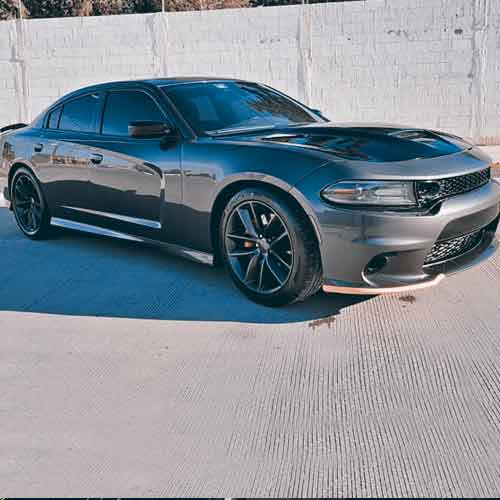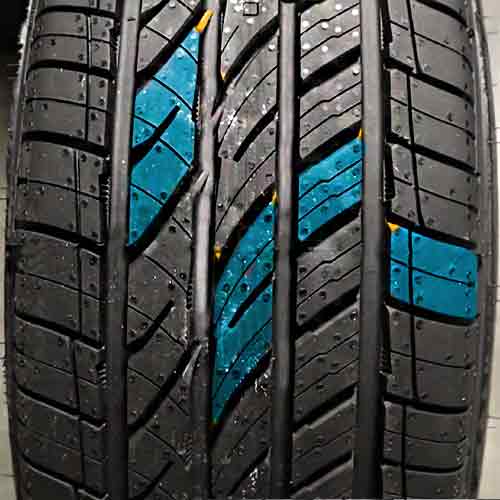The Cooper ProControl stands out as a decent grand touring all-season tire, aiming to provide a balanced performance across various weather conditions. Let’s see how it measures up in terms of handling, comfort, and efficiency.

Key Takeaway
So the Cooper ProControl delivers solid performance in terms of directional grip and stability, whether it’s on dry or wet roads. However, there’s room for improvement in handling and lateral traction in both these dry/wet environments. And speaking of drawbacks, the tire really needs to improve its overall comfort performance too. But on a positive note, it delivers an appreciable winter performance, despite not being branded with 3PMSF rating.
Facts on Sizes
The tire comes in 16 to 22 inches rims (66 total sizes). And they come with following specs.
- Speed ratings: T, H, V and W.
- Load ratings: SL and XL.
- Tread depth: 10 to 12.5/32″.
- Weight: 20 to 43 lbs.
- UTQG: 600 AA for W speed rated sizes, while 700 A A for T, H and V.
- Treadwear warranty: 70k for for H/V speed rated, and 60k for W.
- Winter ratings: Only M+S, (3PMSF not available).
- Internal Construction: Single polyester casing with two steel belts and a single nylon cap ply.
Tread Pattern
The Cooper ProControl tire is designed with a distinctively aggressive asymmetrical tread pattern.

It’s structure is divided up in to 5 sections, the block columns you see (called ribs in the tire world).
The outermost two sections, known as the shoulders, feature blocks with prominent “plus” shaped cuts, functioning as in-groove notches. These shoulders are equipped with dual-directional biters: snow-vices aimed towards the center and additional notches on the sidewalls to enhance lateral grip.
In the central region, (out of the 3 remaining ribs), the two are notably more aggressive and symmetrical in design. They feature sharp chamfered edges and lateral voids to provide traction, and counteract hydroplaning, along with angled siping that improves grip in wet conditions.
While the remaining rib, incorporates simpler, laterally aligned sipes and grooves with offset edges, offering a balanced performance.
Additionally, the ProControl features a wear indicator on the central rib, telling about how much tread depth is left.
Dry Performance
Dry performance looks at two aspects. How well the tire move longitudinally and laterally. Let’s check them out individually.
Longitudinal Grip
The Cooper excels beautifully when it comes to longitudinal grip, due to its optimal interaction with the road surface. This is largely thanks to its expansive + biting contact patch, which enhances friction and grip.
The tire’s design, featuring slanted blocks with alternating angles along the ribs, maximizes rubber-to-road contact, significantly improving traction. Plus with a well engineered interlocking in-block notches, that grip gets further enhanced.
Furthermore, the tire also provides superb stability thanks to its blocks having chamfered edges and reinforced foundations.
This particularly enhances the tire’s on-center feel (or straight line stability).
So overall it makes sense why dry braking is ProControl’s strongest performance aspect. In fact the tire’s overall performance here is really close to Michelin CrossClimate 2 (which I’ve rated the best, for overall longitudinal grip in my my list of top grand touring tires).
Lateral Grip and Handling
Lateral grip refers to the maximum lateral traction a tire provides, especially at the apex of a turn. This grip largely depends on the tire’s tread shoulders and sidewalls, which bear the most concentrated weight during a turn, making them the primary points of road contact.
Understanding this it can be seen how the ProControl excels here as well, thanks to its very packed up shoulder lugs with off-set edges in particular providing the tire with excellent grip, as seen by its lateral g forces measurements.
Though it still lacks in overall handling. I mean when compared to its closest competitor, the General Altimax RT45, the ProControl falls short by an average of 0.5 seconds in handling lap time tests.
This is because overall handling is the complex balance of both lateral grip and steering response and Cooper lacks in later, not providing quick enough steering feedback.
Despite its excellent performance in cornering entry, aided by faster braking and directional traction, and a superior on-center feel, the tire doesn’t maintain the same level of performance in mid-cornering where it shows susceptibility to understeering.
This issue is largely attributed to the tire’s extra weight. I mean the ProControl is one of the heaviest in its category. So it generates a lot of momentum inertia taking more effort and driver’s input to steer (leading to an understeer).
To be more specific the tire’s heavier weight basically causes its lugs to bend more. And this bending delays their return to their original shape, resulting in slower steering response, despite their solid reinforced foundations.
Needless to say with this delayed steering feedback, the overall handling times suffer too.
Wet Performance
The Cooper ProControl demonstrates outstanding wet performance, surpassing almost all of its direct competitors thanks to its impressive clearing capability.
And this is because of the tire’s very effective groove and sipe structure.
So, here’s how it works: the grooves are like the tire’s first line of defense against hydroplaning. They shove most of the water out of the way. Then, the sipes come into play, mopping up and shooting out any leftover water bits as the tire spins.
Basically sipes (tiny slits on tread) suck up the remaining moisture, drying out the road further for rubber to grip on. Now the great thing about ProControl is its very effective multitude of sipes, which vary in angles across different ribs, providing “multi-directional” wet grip.
Meaning you get a nice mixture of lateral and directional wet traction.
Plus with its interconnected 4 wide circumferential grooves, it takes out a ton of water from the start, lifting off a lot of burden from sipes to begin with, boosting wet traction further.
Though its not the perfect wet tire, if you ask me and there’s still some room for improvement. And problem here is nothing new and is again the tire’s heavier weight causing understeering (just like seen in dry conditions).
But yes, aside form this minor drawback, the tire excels in other key areas, notably its wet braking which actually ranks highly in the world of grand touring all-season tires.
To put things into prespective the ProControl offers an impressive 15 feet shorter braking distance (on average) compared to the Extensa AS2 (which is the latest Toyo’s tire offering, and not just a direct Cooper’s competitor here).
Snow and Ice Performance
When it comes to winter performance, there’s not much to complain about with ProControl (even though the tire doesn’t offer the 3 Peak Mountain Snowflake certification).
So what’s making it shine here? Well consider these points.
First up, there’s this Advanced Rubber Composition. It’s not your ordinary rubber. This stuff is mixed with a ton of silica and has these multi-cell compounds.
These compounds are composed of minuscule bubbles and tubes that actively wick away moisture from the surface of the ice, giving the tire some serious grip when it’s slippery out there.
Then there’s the Thermally Adaptive Rubber, which offers compounds such as Polybutadiene, which maintain tread flexibility in low temperatures keeping the effectiveness of the tire biters/notches constant.
Basically this ensures that all the sipes and in-groove notches (the tire offers) do not freeze up with colder conditions and keep their biting abilities alive.
Another thing about the ProControl is that it often comes in a narrower section width (on a lot of its sizes, I mean) compared to other tires.
What’s the big deal with that? Well, it means the tire can push down harder on the snow, packing it into the grooves and sipes. And yes tire’s heavier weight is also helping to that.
This creates a sort of snow-on-snow action, which is key for staying steady on snowy roads. And this snow-to-snow contact is super important because snowflakes stick to each other way better than they stick to rubber, increasing traction.
All in all, the ProControl does a fantastic job, especially when you stack it up against other non-weather tires that also don’t have the 3PMSF tag just like the Cooper.
Noise Comfort
The Cooper ProControl is not quiet enough and needs to improve its performance here, as during tests, this tire emerged as relatively noisy compared to others in its class, with higher-than-average decibel levels.
Interestingly the tire noise varies a lot with speed. I mean at lower speeds, it gives off a mix of low-pitched grinding and high-pitched whining sounds. And as you speed up, the tire tends to make a unique two-tone cavity sounds.
This is mainly because of the tire’s less effective pitch sequencing. What’s that? Well its a design feature that basically creates a range of sound frequencies, which helps in somewhat diminishing the overall loudness of the noise, rendering it less intrusive.
So if road quietness is your priority, I’m afraid this tire isn’t going to impress you. Instead you should check out the Pirelli Cinturato AS SF2 (review), the quietest tire when it comes to grand touring category.
Ride Smoothness
Road smoothness can be evaluated based on two key aspects: tire’s ability to absorb road bumps and its stability provision. And in both these areas, the ProControl does not particularly stand out.
This is because Cooper tire here is made with a stiff rubber blend, equipped by an even harder secondary rubber layer that underpins the tread lugs.
Now sure this design does great when it comes to cornering (particularly in dry conditions), it really lacks in terms of absorbing road shocks.
Moreover, the tire’s internal construction isn’t helping here either. I mean the tire features a single polyester casing with a high turn-up, meaning the cords stretch further up the sidewalls, adding to the stiffness.
Fuel Economy
The fuel efficiency is another performance aspect of ProControl which isn’t impressing anyone.
A primary reason for this is its aggressive tread design, which incorporates numerous elements known as “biters” which significantly enhance the friction between the tire and the road, leading to increased rolling resistance.
Additionally, the tire’s relatively heavier structure further contributes to this issue.
The increased weight exerts more pressure on the lugs, causing them to flex more, adding to the overall energy expenditure, (with fuel energy being converted into heat rather than being efficiently used for tire rotation instead).
But there’s a silver lining.
I mean the ProControl still provides a good enough economy with sizes having “T” speed ratings. These sizes might not offer the same level of grip, but they do better in terms of miles per gallon (mpg).
Though make sure to only go for those (sizes) if they are recommended by your car manufacturer.
For Your Info: Speed rating is actually directly proportional to rolling resistance. I explained it more here: https://tiredriver.com/speed-rating-on-tires/
To Conclude
In summary, the Cooper ProControl presents a mixed bag of performance attributes across various conditions.
For dry performance, its longitudinal grip and on-center stability are very strong points, but the tire falls short in lateral grip and handling.
Same is the case when it comes to wet conditions, where the tire excels in braking, but understeers in terms of handling.
Though winter performance remains strong in both key areas.
Other than this the tire provides a good enough longevity, but needs to improve its fuel economy (though sizes with T speed ratings are okay here).
And yes its comfort performance is also below average looking at other tires in its category.